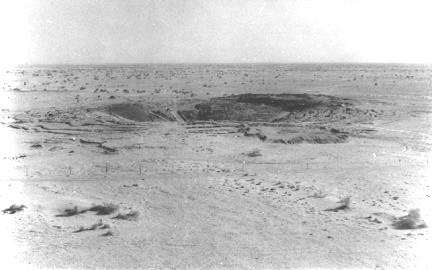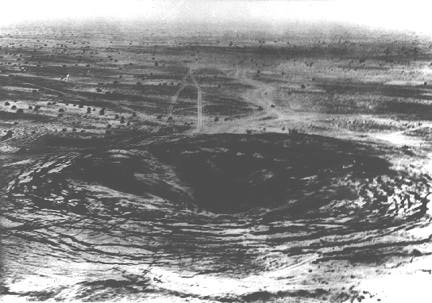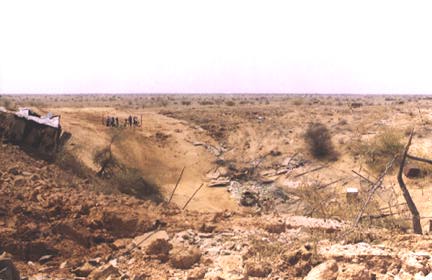 Pokhran is a city and a municipality located in Jaisalmer district in the Indian state of Rajasthan. It is a remote location in the Thar Desert region and served as the test site for India's first underground nuclear weapon detonation.Pokhran shot into International Limelight on September 7, 1972 when the then Indian Prime Minister Indira Gandhi gave authorization to the scientists at the Bhabha Atomic Research Centre (BARC), Trombay to detonate an indegenously designed nuclear device. Throughout its development, the device was formally called the "Peaceful Nuclear Explosive", but it was usually referred to as the Smiling Buddha. Smiling Buddha was the code-name of the project as a signal to China and was scheduled to occur on May 18, 1974 (the official test date), Buddha Jayanti, a festival day in India marking the birth of Gautama Buddha. The code name of the project has been listed as Operation Happy Krishna according to US Military resources.
Pokhran is a city and a municipality located in Jaisalmer district in the Indian state of Rajasthan. It is a remote location in the Thar Desert region and served as the test site for India's first underground nuclear weapon detonation.Pokhran shot into International Limelight on September 7, 1972 when the then Indian Prime Minister Indira Gandhi gave authorization to the scientists at the Bhabha Atomic Research Centre (BARC), Trombay to detonate an indegenously designed nuclear device. Throughout its development, the device was formally called the "Peaceful Nuclear Explosive", but it was usually referred to as the Smiling Buddha. Smiling Buddha was the code-name of the project as a signal to China and was scheduled to occur on May 18, 1974 (the official test date), Buddha Jayanti, a festival day in India marking the birth of Gautama Buddha. The code name of the project has been listed as Operation Happy Krishna according to US Military resources.
First underground nuclear explosion at Pokhran in Rajasthan on May 18, 1974. Photo shows a view of the creater formed after the explosion. 
The head of the development team was Raja Ramanna. Other key members were P.K. Iyengar, Rajagopala Chidambaram, and Nagapattinam Sambasiva Venkatesan. The project employed no more than 75 scientists and engineers from 1967-1974. Keeping it small served to aid in the preservation of secrecy, according to the researcher Jeffrey Richelson.The device used a high explosive implosion system, developed at the Defence Research and Development Organisation (DRDO)'s Terminal Ballistics Research Laboratory (TBRL), Chandigarh, based on the American design from World War II. But the Indian design was simpler and less sophisticated than the American system. The 6 kg of plutonium came from the CIRUS reactor at BARC, Trombay, Mumbai (then Bombay). The neutron initiator was a Polonium-Beryllium type (again like those used in early U.S. bombs of the Fat Man type) code-named "Flower." The complete core was assembled in Trombay before transportation to the test site. In 1975, Homi Sethna (chairman of the Atomic Energy Commission), Raja Ramanna and Nag Chaudhuri (head of the DRDO) received the Padma Vibhushan - India's second highest civilian award. Five other project members received the Padma Shri - India's fourth highest civilian award.
 Pokharan-II Pokharan-II refers to test explosions of five nuclear devices, three on 11 May and two on 13 May 1998, conducted by India at the Pokhran test range. The test was conducted when the Bharatiya Janata Party (BJP) government was in power with Atal Bihari Vajpayee as Prime Minister. These nuclear tests resulted in a variety of sanctions against India by a number of major states. The detection of the test preparations by American satellites in 1995, had taught a lesson to the Indian scientists. It was decided that preparations for the May 1998 tests should be undertaken under a cloud of secrecy so that foreign powers could not detect the preparations and try to pressure the government. Extensive measures were taken in order to deceive intelligence agencies around the world. The decision to test was not disclosed even to senior cabinet ministers. The preparations were managed by a closed group of scientists, military officers and politicians.Dr. A.P.J. Abdul Kalam, the Scientific Adviser to the Prime Minister, and Dr. R. Chidambaram, the head of the Department of Atomic Energy, were the chief coordinators for the operation. They were assisted by the 58th Regiment of the Army Engineering Corps in preparing the test site. Scientists from the Bhabha Atomic Research Centre (BARC) and the Defence Research and Development Organization (DRDO) were involved in assembling the weapons, moving them to Pokhran, placing them into shafts in the ground and laying a network of sensors to gather data during the explosions.
Pokharan-II Pokharan-II refers to test explosions of five nuclear devices, three on 11 May and two on 13 May 1998, conducted by India at the Pokhran test range. The test was conducted when the Bharatiya Janata Party (BJP) government was in power with Atal Bihari Vajpayee as Prime Minister. These nuclear tests resulted in a variety of sanctions against India by a number of major states. The detection of the test preparations by American satellites in 1995, had taught a lesson to the Indian scientists. It was decided that preparations for the May 1998 tests should be undertaken under a cloud of secrecy so that foreign powers could not detect the preparations and try to pressure the government. Extensive measures were taken in order to deceive intelligence agencies around the world. The decision to test was not disclosed even to senior cabinet ministers. The preparations were managed by a closed group of scientists, military officers and politicians.Dr. A.P.J. Abdul Kalam, the Scientific Adviser to the Prime Minister, and Dr. R. Chidambaram, the head of the Department of Atomic Energy, were the chief coordinators for the operation. They were assisted by the 58th Regiment of the Army Engineering Corps in preparing the test site. Scientists from the Bhabha Atomic Research Centre (BARC) and the Defence Research and Development Organization (DRDO) were involved in assembling the weapons, moving them to Pokhran, placing them into shafts in the ground and laying a network of sensors to gather data during the explosions.
The Regiment 58 Engineers had learned much since the aborted 1995 test preparations about avoiding detection by American satellites. Much work was done at night, and heavy equipment was always returned to the same parking spot at dawn so that satellite image analysts would conclude that the equipment was never moved. Piles of dug-out sand were shaped to mimic the wind shaped dune forms in the desert area. The shafts were dug under camouflage netting. When cables for sensors were laid they were carefully covered with sand, and native vegetation was replaced to conceal the digging  The scientists involved in the operation took care to ensure that even their close friends and colleagues would not detect the work being undertaken at Pokhran. All scientists involved in the operation did not depart for Pokhran simultaneously, but left in groups of two or three. One group would use the pretext of attending a seminar or a conference, and would tell their wives that they could not be contacted while they were away. Shakti-1 Thermo-Nuclear weapon during 1998 Pokhran-II nuclear tests.Tickets were bought for a destination other than Pokhran (or cities nearby) under pseudonyms, and after arriving at their destination, the group would secretly leave for the military base in Jaisalmer from where they would be taken by the army to Pokhran. After finishing their work the group would return, retracing their path. Then another group would leave for the range employing similar means to do their work. In this way, information about the test was kept tightly under wraps. All technical staff at the range wore military fatigues, so that in satellite images they would appear to be military personnel maintaining the test range
The scientists involved in the operation took care to ensure that even their close friends and colleagues would not detect the work being undertaken at Pokhran. All scientists involved in the operation did not depart for Pokhran simultaneously, but left in groups of two or three. One group would use the pretext of attending a seminar or a conference, and would tell their wives that they could not be contacted while they were away. Shakti-1 Thermo-Nuclear weapon during 1998 Pokhran-II nuclear tests.Tickets were bought for a destination other than Pokhran (or cities nearby) under pseudonyms, and after arriving at their destination, the group would secretly leave for the military base in Jaisalmer from where they would be taken by the army to Pokhran. After finishing their work the group would return, retracing their path. Then another group would leave for the range employing similar means to do their work. In this way, information about the test was kept tightly under wraps. All technical staff at the range wore military fatigues, so that in satellite images they would appear to be military personnel maintaining the test range
 A general view shows the carter at Shakti-1 of underground nuclear explosion test conducted on May 11, 1998 at Pokhran in Rajasthan.
A general view shows the carter at Shakti-1 of underground nuclear explosion test conducted on May 11, 1998 at Pokhran in Rajasthan.
On the diplomatic front, India adopted a policy of ambiguity about deciding to go nuclear. Statements by Indian politicians and diplomats gave an impression to the world that India was not yet decided about its nuclear status. Deliberate steps were taken to ensure that the world community would not take the BJP's campaign promises seriously. In separate meetings with American officials, Foreign secretary K.Raghunath and Defence Minister George Fernandes stated that India had not yet decided about going nuclear and they also conveyed to the officials that the National Security Council would be meeting soon to discuss the matter and decide about the nuclear option. The council was to meet on the 26th of May. Both the Indian officials had categorically told the Americans that "there would be no surprise testings". All this led the Americans and the world community to believe that India was not going to pursue the nuclear option in the near future. They did not take the BJP's campaign promises seriously and hence did not expect an Indian nuclear test so soon.
